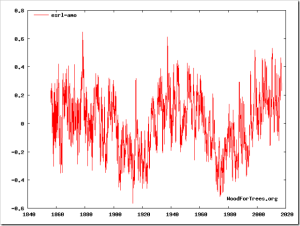For a while I’ve been convinced there is a strong correlation between the Atlantic Multidecadal Oscillation and “global temperature”. AMO is shown below, I was going to post a graph of global temperature, but the problem these days is finding any graph that any longer represents global temperature (most are just the fraudulent lies of data adjusters – let’s hope that soon changes!!).
However, this post is not about the fraudulent global temperature, instead I was trying to work out when the peak AMO was /will be and also the peak cooling. We have on this graph the following very rough dates:
- 1860-1880 maximum
- 1890-1905 – cooling
- 1910-1920 – minimum
- 1930 – warming
- 1940-1960 -maximum
- 1967 – peak cooling
- 1973 minimum
- 1990-2000 warming
- 2000-??? – maximum
This gives rise to the following:
- max-max ~80yrs
- cool-cool ~70yrs
- min-min ~60yrs
- warm-warm ~ 65yr
We also have the start of another maximum at 2000, but as yet no end. There are other similar starts at 1860 & 1940. This gives another estimate of 70 years. Including this with the above we obtain an average of: 69yrs with a typical range of +/- 10yrs.
Maximum
If this patterns continues, give the best estimate of the last maximum was 1950 – (80-70)/2 = 1945, the best estimate of the next maximum is 1945+70 = 2015 (range 2005-2025). This is a little later than would be expected with an earliest start of the maximum at 2000.
Cooling
Best estimate of maximum cooling is 1967 + 69yrs = 2036 (range 2026-2046)
Worst/best Scenario global temperature
The best estimate is that the AMO maximum will end at latest around 2025.
However …mother nature does not like doing anything predictable.
If we do have a La Nina, we are likely to see cooling for perhaps 1-4years. So, any La Nina cooling will end in plenty of time for another El Nino to kick us into a warm spike perhaps around 2021-2025. So if AMO is dictating global temperature, then any El Nino after the La Nina is likely to kick up temperatures again.
However … if we don’t get a La Nina and instead we go into El Nino. That means we may see warmer temperatures for perhaps 2-4years. If so, and AMO is dictating climate, then the next El Nino will be too late to show as “exceptional” warming.
Global Warming Alarmism Forecast
As a very rough estimate, it therefore appears that we have another 3-8 years of “global warming alarmism” to deal with. We must not forget however, that we expect very modest warming from the rise in CO2. This may slightly delay any warming and could modestly enhance any El Nino warming peak. So, it is possible that there will be another El Nino warming stronger than the last two in the next 8 years. However, (without data fiddling) this will not be anywhere near large enough to match the global warming forecasts, but it will be large enough to keep the hopes of alarmists alive.
However around 2025 it is likely we will begin to see a substantial drop in global temperatures with a peak cooling expected 2026-2046. If this cooling occurs, then we will undoubtedly see a resurgence of the global cooling alarmism, if this cooling does not occur, then either the effects of CO2 are greater than that of their direct greenhouse effect, or AMO is not a good predictor of global temperature. And global warming alarmism will flourish.
However
If the alarmists are not totally removed from their jobs by Trump and other governments – then it will become so endemic that we’ll have no idea what is happening to global temperature – and we may as well go back to sacrificing goats.



The fact that significant temperature rises depend on kicks from El Ninos should itself be seen as a sign that CO2 theory is out of step with reality.
Quite so!